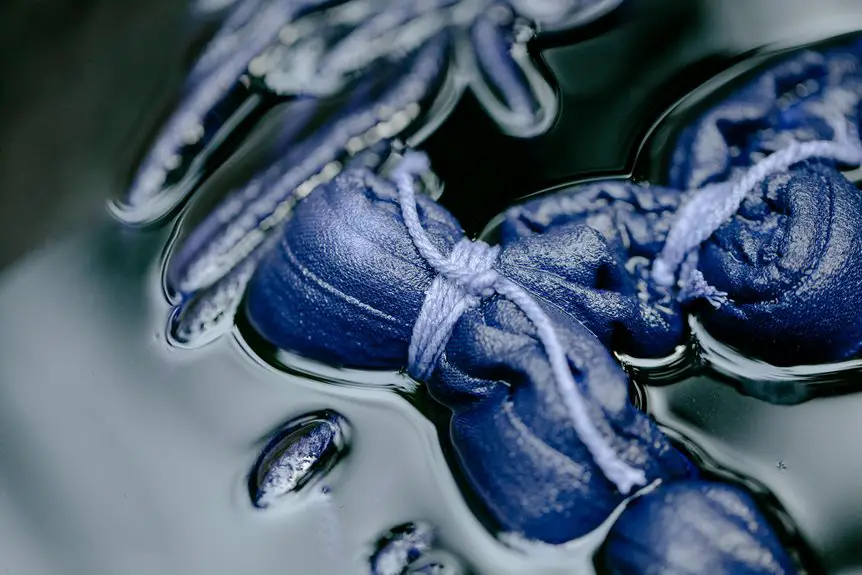It’s interesting how a simple cotton T-shirt, something you might grab without a second thought, can require over 2,700 liters of water to produce. That’s a staggering amount, especially when you consider the regions facing severe water shortages. As you explore the intricate relationship between textile production and global water scarcity, you’ll uncover the hidden impacts on ecosystems and communities that often go unnoticed. What’s the true cost of our clothing choices?
Table of Contents
Key Takeaways
- Textile production, especially cotton, consumes vast amounts of water, with a single T-shirt requiring over 2,700 liters throughout its lifecycle.
- The industry’s growth exacerbates water scarcity concerns, particularly in water-stressed regions where textile production is prevalent.
- Water-intensive processes like dyeing and finishing further deplete local water sources, impacting ecosystems and wildlife.
- Pollution from chemicals used in textile production contaminates water, affecting both human health and local agriculture.
- Sustainable practices, such as using alternative fibers and water-efficient technologies, are essential to mitigate the industry’s water footprint.
The Scale of Water Consumption in Textile Production
When you consider the vast scale of textile production, it’s startling to realize just how much water is required throughout the process. From growing cotton to dyeing fabrics, water plays a critical role.
You mightn’t know that producing just one cotton shirt can consume over 2,700 liters of water. This immense demand contributes considerably to global water scarcity.
As you explore further, you’ll find that the majority of this water is used in the cultivation phase, but considerable amounts are also needed for processing and finishing textiles.
The industry’s expanding growth amplifies these concerns, making it essential for you to understand the impact of your clothing choices.
Water Usage in Different Textile Products
When you consider the water footprint of a simple T-shirt, you might be surprised by how much water it actually takes to produce.
Jeans manufacturing requires even more water, highlighting the significant differences in water needs among various textile products.
Let’s explore the specific water requirements for different fibers and how they impact our water resources.
T-shirt Water Footprint
A single T-shirt can consume over 2,700 liters of water throughout its lifecycle, from cotton cultivation to production. This staggering amount stems mainly from the water-intensive process of growing cotton, which requires significant irrigation.
You mightn’t realize that factors like dyeing and finishing also contribute substantially to this footprint. Each step in the manufacturing process demands water, adding up quickly.
When you consider the global demand for T-shirts, the cumulative impact on water resources becomes alarming. By understanding the T-shirt’s water footprint, you can make more informed choices about your wardrobe.
Opting for sustainable brands or reducing consumption can help mitigate the strain on our precious water resources. Every small decision counts in the fight against water scarcity.
Jeans Manufacturing Water Needs
Although jeans are often seen as a staple in most wardrobes, their production comes with a hefty water price tag. You might be shocked to learn that it takes around 7,000 liters of water to produce just one pair of jeans. That’s enough water to meet the daily needs of an individual for over six years! This staggering figure highlights the immense water consumption involved in denim production.
| Stage of Production | Water Usage (Liters) | Emotional Impact |
|---|---|---|
| Cotton Growth | 3,000 | Deforestation, Loss of Habitats |
| Dyeing | 2,000 | Water Pollution |
| Finishing | 1,000 | Waste and Chemicals |
| Washing | 1,000 | Resource Depletion |
| Total | 7,000 | Scarcity Awareness |
Consider how your choices affect our planet.
Fiber-Specific Water Requirements
The water footprint of textiles varies considerably depending on the fiber used.
When you choose different types of fabrics, you’re also considering how much water each requires in production.
Here’s a quick look at some common fibers and their water needs:
- Cotton: Requires about 7,000 liters per kilogram, making it one of the thirstiest fibers.
- Wool: Uses around 1,100 liters per kilogram, depending on the farming practices.
- Polyester: Though derived from petroleum, it still needs about 1,200 liters per kilogram during manufacturing.
- Lyocell (Tencel): Uses about 800 liters per kilogram, often considered more sustainable due to its closed-loop process.
Impact on Local Ecosystems
When textile production ramps up in water-scarce regions, it markedly disrupts local ecosystems. You’ll notice that water sources get diverted for irrigation, drastically reducing availability for native flora and fauna.
This depletion can lead to habitat loss, pushing some species to the brink of extinction. You might see increased pollution from chemicals used in dyeing and finishing processes, which can contaminate local waterways and further harm aquatic life.
Additionally, overextraction of water can alter soil composition, making it less fertile for other agricultural uses. As you observe these changes, you may realize that the delicate balance of local ecosystems is at risk, impacting not just wildlife, but also communities that rely on these natural resources for their livelihoods.
Contributions to Global Water Scarcity
As textile production grows, it considerably contributes to global water scarcity, especially in regions already facing shortages. The industry’s demand for water is staggering, and it exacerbates existing environmental issues.
When you consider the scale of textile production, you’ll see how it impacts water resources directly. Here are some key ways it contributes to the problem:
- High Water Usage: Producing a single cotton t-shirt can require over 2,700 liters of water.
- Pollution: Dyes and chemicals contaminate local water sources, making them unusable.
- Depletion of Aquifers: Over-extraction for irrigation and processing depletes essential water supplies.
- Climate Change: Increased production leads to higher temperatures and altered precipitation patterns, worsening water availability.
These factors highlight the urgent need for addressing water usage in textile production.
Sustainable Solutions and Innovations
Addressing the water challenges posed by textile production calls for innovative and sustainable solutions that can reshape the industry.
You can consider adopting water-efficient dyeing techniques, such as digital printing, which uses considerably less water than traditional methods. Implementing closed-loop systems can also minimize wastewater, allowing you to recycle water and reduce consumption.
Switching to organic and sustainable materials further decreases water usage during cultivation. Collaborating with suppliers to guarantee eco-friendly practices can enhance your supply chain’s overall sustainability.
Finally, investing in research and development of alternative fibers, like hemp or recycled polyester, can lessen the industry’s burden on freshwater resources.
Future Regulatory and Consumer Trends
While the textile industry faces increasing scrutiny over its water usage, future regulatory and consumer trends are likely to drive significant changes.
As consumers grow more aware of environmental impacts, you’ll notice a shift in demand for sustainable practices. Regulations will also tighten, pushing companies to adopt water-efficient methods.
Here are some trends to watch:
- Increased transparency in water usage and sourcing
- Stricter regulations on wastewater management
- Growing consumer preference for eco-friendly brands
- Rise of certifications focused on sustainable practices
These trends signal a pivotal moment for the industry.
As you make choices about what to buy, your voice will contribute to a more sustainable and responsible textile market, influencing companies to prioritize water conservation.
The Need for Industry Transformation
The textile industry stands at a crossroads where transformation isn’t just beneficial—it’s necessary. As you consider your role, recognize that adopting sustainable practices can greatly reduce water usage and pollution.
You can push for innovations in dyeing technologies and recycling methods that minimize water consumption. Embracing circular economy principles could help keep resources in use longer and lessen dependence on fresh water.
Collaborating with stakeholders—from manufacturers to consumers—creates a unified front in advocating for responsible water management. By prioritizing sustainable sourcing and production, you not only contribute to alleviating global water scarcity but also position your brand as a leader in the industry.
Collaboration across the supply chain empowers brands to champion responsible water management and lead the way in sustainability.
Together, we can redefine textile production for a more sustainable future.
Frequently Asked Questions
How Does Climate Change Affect Water Availability for Textile Production?
You might think climate change only affects weather, but it drastically impacts water availability for textile production. Droughts and erratic rainfall reduce water supplies, forcing manufacturers to adapt or face significant production challenges.
What Role Do Consumers Play in Reducing Water Usage in Textiles?
You can reduce water usage in textiles by choosing sustainable brands, opting for less frequent washing, and supporting initiatives that promote water-efficient practices. Your choices directly influence companies to adopt more responsible water management strategies.
Are There Certifications for Sustainable Textile Production Methods?
Yes, there are certifications for sustainable textile production methods. You can look for labels like GOTS, OEKO-TEX, or Fair Trade, which guarantee environmentally friendly practices and ethical labor standards in the textile industry.
How Can Local Communities Combat Textile-Related Water Pollution?
To combat textile-related water pollution, you can organize community clean-up events, advocate for stricter regulations, support local sustainable brands, and educate others about responsible consumption. Every action counts in protecting your water resources and environment.
What Are the Economic Impacts of Water Scarcity on Textile Manufacturing?
Water scarcity drives up production costs, forcing you to find alternative sources or reduce output. It limits access to quality materials, impacting product quality and market competitiveness, ultimately affecting your bottom line and business sustainability.
- How to Get Started With Tie-Dye: a Minimalist’s Supply List - July 13, 2025
- Comparing All Major Resist Dyeing Techniques - July 13, 2025
- Batik Technique: Using Wax and Dye to Create Art - July 13, 2025





